This leaflet answers common questions about recurrent shoulder dislocations - low trauma. If you would like further information, or have any worries, please do not hesitate to ask your nearest clinician

What is a recurrent shoulder dislocation - low trauma?
This is when your shoulder comes out of joint after low energy injury.
Healing
Multiple shoulder dislocations can cause damage to the soft tissues of the shoulder joints. It takes approximately six weeks for this to settle.
Pain, swelling, pins and needles
Your shoulder may be swollen, and you will have some pain. Taking pain medication and using ice or cold packs will help. More information is on the next page. You may have a small patch of numbness on the outside of the shoulder. This will improve with time. Please contact us if you have any of the following symptoms:
- Pins and needles or numbness of the arm or in your hand
- If you are struggling to move the hand or arm at all
- You have pain or symptoms anywhere other than your shoulder
Wearing your sling
Use your sling for comfort only and no more than one week. You can take it off to wash, dress and do your exercises.
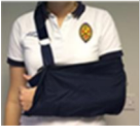
Exercise and activity
It is important to start gentle exercises straight away to prevent stiffness.
You will find pictures and instructions for your exercises below. Do not lift your arm over shoulder height for the first three weeks. You should not do any heavy lifting or overhead movement for the first six weeks
Follow-up
You will see a shoulder specialist within six weeks of your injury. The Specialist will assess your shoulder and discuss the best management plan with you. We have discussed a referral to physiotherapy and will refer if required.
Caring for your injury: Weeks 1 – 3
Wear your sling for comfort in the first week, including in bed at night. You may find it more comfortable to sleep propped up on pillows. Remove the sling for washing, dressing and exercises
Using a cold pack will help with your pain and swelling. You can use an ice pack or bag of frozen peas wrapped in a damp towel. Put this on your shoulder for 15 minutes every few hours. Make sure the ice isn’t in direct contact with your skin.
Exercises
Start these exercises straight away. Hand, wrist, and elbow exercises are only needed while you are wearing a sling. You can stop these once they become easy, and you have full movement. Try to do these exercises four to five times a day. Repeat each exercise 10 times.
Hand, wrist, and elbow exercises

Open and close your hand. Next, move your wrist up and down. Repeat 10 times.
After a few days, hold a soft ball or rolled up socks. Squeeze the ball and hold for five seconds. Repeat five times.
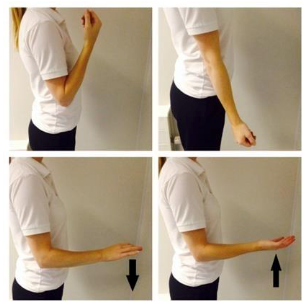
Bend and straighten your elbow. Repeat 10 times.
Bend your elbow to a right angle. Slowly turn your palm up to the ceiling and down to the ground. Repeat 10 times.
Posture exercise
Bring your shoulders back and gently squeeze your shoulder blades together. Hold for 20-30 seconds.
Repeat five times.

Shoulder pendulum exercise
Stand next to a firm surface. Support yourself with your un-injured arm and lean forwards. Let your injured arm relax and hang down to the ground.
Gently swing your arm, making a small movement. Try to do this forward and backward, side to side and in small circles. Aim to do this for one to two minutes in total. You do not need to push into pain. Remember to keep your arm relaxed.
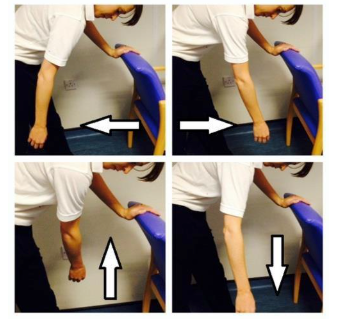
Caring for your injury: Weeks 3-6
You can now return to light activities. Gradually increase your day-to-day activity and be guided by any pain or discomfort you experience. Remember to avoid heavy lifting.
Exercises
Start these exercises three weeks after your injury. Try to do them four to five times a day. Repeat each exercise 10 times.
Active assisted flexion
Use your other hand to lift your injured arm up in front of you.
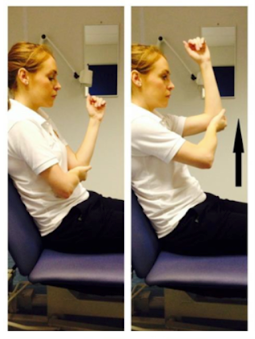
Active assisted external rotation
Keep the elbow of your injured arm tucked into your side and your elbow bent. Hold onto a stick, umbrella, or something similar. Use your good arm to push your injured hand outwards. Remember to keep your elbow tucked in.
If you don’t have a stick, hold your injured arm at the wrist, guide it with your good hand.
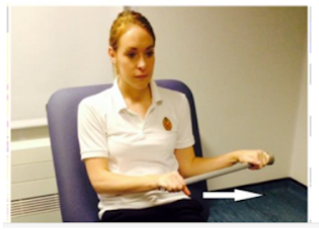
Caring for your injury: Weeks 6-12
You should be back to most of your normal activities. Take care with heavy or overhead tasks which may still be uncomfortable.
Exercises
Start these exercises six weeks after your injury. Try to do these exercises four to five times a day. Repeat each exercise 10 times.
Active Flexion
Lift your arm forwards in front of you. Try to raise the arm as high as you can. You do not need to push into pain. If this is too difficult, try the same movement with a bent elbow.

Active abduction
With your palm facing forwards, move your arm out to the side in a big arc. Try to raise the arm as high as you can. You do not need to push into pain. If this is too difficult, try the same movement with a bent elbow.
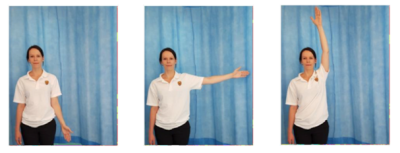
Active external rotation
Start with your elbow bent by your side. Move your forearm out to the side, keeping your elbow bent and near your waist.
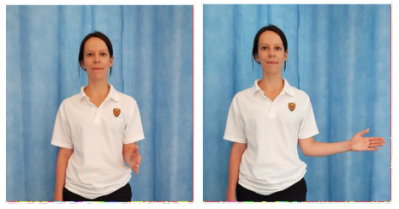
Concern about your symptoms
If you are concerned about your symptoms and/or struggling to return to exercise, please contact the virtual fracture clinic.
I am struggling with my sling. What do I do?
Contact the virtual fracture clinic. We can give advice or change your sling if needed.
Driving
You can return to driving when:
- You are no longer using a sling
- You can move comfortably and
- You can control the vehicle safely.
Please refer to the DVLA website regarding your fitness to drive if required.
Fitness for work statement
You can get a fitness for work statement from your GP or the doctor at your fracture clinic appointment.
 Translate
Translate